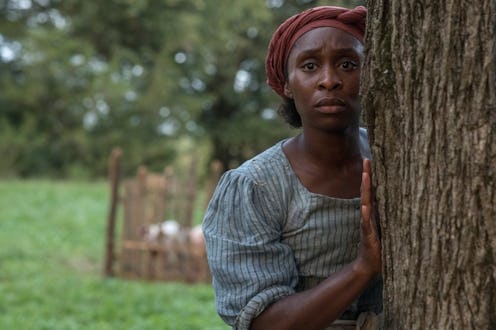Entertainment
‘Harriet’ Director Kasi Lemmons On Staying True To Who Tubman Was, Not Just What She Did

Early in the biopic Harriet (out Nov. 1), a still enslaved Harriet Tubman (Cynthia Erivo) informs her owners that she's hired a lawyer. She wants to prove that mother, a "term slave," should be free, since she's reached the agreed upon age of 45. Though it's not surprising that Harriet and her family are rejected in this, it may surprise some audiences that a slave could hire a lawyer at all. But, this is just one fascinating aspect of Harriet that actually is accurate to the abolitionist's real life.
"I thought that was kind of brilliant," says writer/director Kasi Lemmons of Tubman's legal maneuver at the New York City press junket for the film. While she notes that, of course, many slave owners did not honor such manumission agreements, some did. And these agreements were fairly common. "I thought it was something that an audience really needed to see, in terms of just all the forms of resistance," Lemmons continues. "Legally, that was her first strategy. 'I'm going to hire a lawyer.' And when that didn't work, 'OK, we need another form of resistance.'"
Through this scene, audiences get their first taste, not just of Tubman's determination, but her character and personality. While her involvement with the Underground Railroad is widely taught, the film delves further into Tubman's attitude, the way she spoke, and how she carried herself than most history books. Thankfully, Lemmons was able to read the activist's own words to get a better sense of who she was, not just what she did.
"Her abolitionist friends, they loved her, and they spoke of her so warmly," Lemmons explains of her research. "But Harriet did a very interesting thing, she told her own story to raise money. She would go do these shows where she would talk about her life. So, the words that she used to talk about her life, I tried to use those words. And she used humor a lot ... I started being able to hear her voice."
One frequent subject of her talks was the visions Tubman said that she experienced. After suffering a head injury at the hands of an overseer at age 12, she began having vivid dreams that she believed were god's way of communicating future events to her. She had a premonition that her siblings would be sold to another owner. Three years before the Emancipation Proclamation was signed, she saw that her people would soon be free. (Tubman tells this story in writer Sarah H. Bradford's 1886 biography.) Lemmons decided to include the visions in her film in the same way Tubman recounted them. "They were so specific, and there was such certitude," she tells Bustle. "There’s no ambiguity in the way she talked about them."
Overall, the film stays faithful to Tubman's story, but, as is the case with most biopics, there are some situations and characters that were altered or added. While slaveowner Eliza Brodess (Jennifer Nettles) was a real person, her son Gideon (Joe Alwyn) is a fictional character inspired by one of Brodess' real sons. Janelle Monáe's boarding house owner character, Marie Buchanon, was a created for the film. Walter (Henry Hunter Hall), who becomes ally of Harriet's after working with a slave catcher, is based on Walter Plowden, who Tubman actually worked with during her time as a spy in the Civil War. "I took him and reversed engineered to when they might have first met and decided how I could treat him in the most interesting way," Lemmons explains.
Audiences may be left wondering whether there's any truth behind a tense scene in which Harriet and a group of escaped slaves are able to pass a bridge in a covered wagon thanks to a mixed race slave who pretends to be a slave owner's son. This scene was inspired by the story of Tubman's escape with a slave named Tilly, who is played in the film by Kathryn Tkel.
"They didn't believe that African Americans had the wherewithal, had the intelligence, had the insight," Lemmons says of how the white men in the film could believe that a woman slave was one of them. "They would never believe they could be ingenious or plan things. The way that they underestimated these people that they lived right next to... that was their downfall in terms of the resistance."
However, perhaps the most striking and emotional moment in the film involves another major crossing: when Harriet jumps over the Mason-Dixon line and secures her own freedom. This scene is a mix of reality and an inspired choice by Erivo.
"Harriet describes very clearly stepping into freedom and looking at her hands to see if she was the same," Lemmons says, "so I knew I wanted to capture that part of it."
It was rainy the day the scene was shot, but the clouds parted at just the right moment. With Virginia standing in for Pennsylvania and a sunset standing in for a sunrise, Lemmons knew they wouldn't have much time. "It's like, 'OK, action, we're going to have one take in this light on the crane.' And [Erivo] did that. She jumped. She was in the moment."
After experiencing Erivo's intuitive portrayal and Lemmons' storytelling, many moviegoers will surely be curious to learn even more about the real Tubman and be inspired by her in their day-to-day lives. At least, that's the result Lemmons is hoping for.
"I think we're in a period where we really do have to fight for our future, and fight for our rights, and fight for our children, and fight for the planet," she says. "I think it's a good time to be reminded of how strong we are and how resilient and what can be accomplished. What one woman can accomplish through sheer force of will."